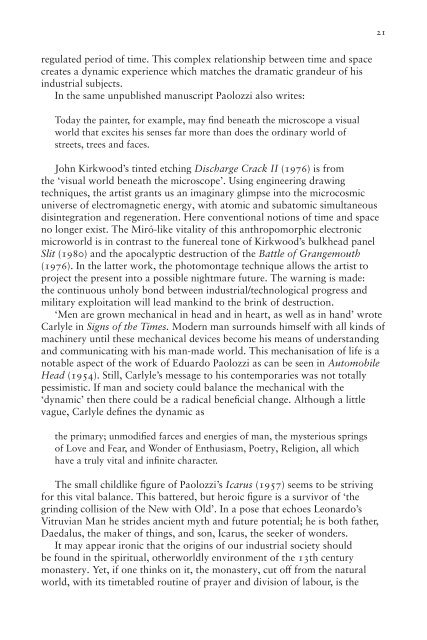Scottish Artists in Historical and Contemporary Context by Bill Hare sampler
Create successful ePaper yourself
Turn your PDF publications into a flip-book with our unique Google optimized e-Paper software.
21<br />
regulated period of time. This complex relationship between time <strong>and</strong> space<br />
creates a dynamic experience which matches the dramatic gr<strong>and</strong>eur of his<br />
<strong>in</strong>dustrial subjects.<br />
In the same unpublished manuscript Paolozzi also writes:<br />
Today the pa<strong>in</strong>ter, for example, may f<strong>in</strong>d beneath the microscope a visual<br />
world that excites his senses far more than does the ord<strong>in</strong>ary world of<br />
streets, trees <strong>and</strong> faces.<br />
John Kirkwood’s t<strong>in</strong>ted etch<strong>in</strong>g Discharge Crack II (1976) is from<br />
the ‘visual world beneath the microscope’. Us<strong>in</strong>g eng<strong>in</strong>eer<strong>in</strong>g draw<strong>in</strong>g<br />
techniques, the artist grants us an imag<strong>in</strong>ary glimpse <strong>in</strong>to the microcosmic<br />
universe of electromagnetic energy, with atomic <strong>and</strong> subatomic simultaneous<br />
dis<strong>in</strong>tegration <strong>and</strong> regeneration. Here conventional notions of time <strong>and</strong> space<br />
no longer exist. The Miró-like vitality of this anthropomorphic electronic<br />
microworld is <strong>in</strong> contrast to the funereal tone of Kirkwood’s bulkhead panel<br />
Slit (1980) <strong>and</strong> the apocalyptic destruction of the Battle of Grangemouth<br />
(1976). In the latter work, the photomontage technique allows the artist to<br />
project the present <strong>in</strong>to a possible nightmare future. The warn<strong>in</strong>g is made:<br />
the cont<strong>in</strong>uous unholy bond between <strong>in</strong>dustrial/technological progress <strong>and</strong><br />
military exploitation will lead mank<strong>in</strong>d to the br<strong>in</strong>k of destruction.<br />
‘Men are grown mechanical <strong>in</strong> head <strong>and</strong> <strong>in</strong> heart, as well as <strong>in</strong> h<strong>and</strong>’ wrote<br />
Carlyle <strong>in</strong> Signs of the Times. Modern man surrounds himself with all k<strong>in</strong>ds of<br />
mach<strong>in</strong>ery until these mechanical devices become his means of underst<strong>and</strong><strong>in</strong>g<br />
<strong>and</strong> communicat<strong>in</strong>g with his man-made world. This mechanisation of life is a<br />
notable aspect of the work of Eduardo Paolozzi as can be seen <strong>in</strong> Automobile<br />
Head (1954). Still, Carlyle’s message to his contemporaries was not totally<br />
pessimistic. If man <strong>and</strong> society could balance the mechanical with the<br />
‘dynamic’ then there could be a radical beneficial change. Although a little<br />
vague, Carlyle def<strong>in</strong>es the dynamic as<br />
the primary; unmodified farces <strong>and</strong> energies of man, the mysterious spr<strong>in</strong>gs<br />
of Love <strong>and</strong> Fear, <strong>and</strong> Wonder of Enthusiasm, Poetry, Religion, all which<br />
have a truly vital <strong>and</strong> <strong>in</strong>f<strong>in</strong>ite character.<br />
The small childlike figure of Paolozzi’s Icarus (1957) seems to be striv<strong>in</strong>g<br />
for this vital balance. This battered, but heroic figure is a survivor of ‘the<br />
gr<strong>in</strong>d<strong>in</strong>g collision of the New with Old’. In a pose that echoes Leonardo’s<br />
Vitruvian Man he strides ancient myth <strong>and</strong> future potential; he is both father,<br />
Daedalus, the maker of th<strong>in</strong>gs, <strong>and</strong> son, Icarus, the seeker of wonders.<br />
It may appear ironic that the orig<strong>in</strong>s of our <strong>in</strong>dustrial society should<br />
be found <strong>in</strong> the spiritual, otherworldly environment of the 13th century<br />
monastery. Yet, if one th<strong>in</strong>ks on it, the monastery, cut off from the natural<br />
world, with its timetabled rout<strong>in</strong>e of prayer <strong>and</strong> division of labour, is the


















